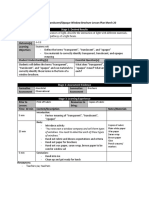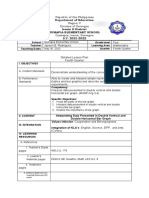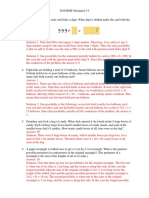Area and Perimeter
Area and Perimeter
Uploaded by
api-285970439Copyright:
Available Formats
Area and Perimeter
Area and Perimeter
Uploaded by
api-285970439Original Title
Copyright
Available Formats
Share this document
Did you find this document useful?
Is this content inappropriate?
Copyright:
Available Formats
Area and Perimeter
Area and Perimeter
Uploaded by
api-285970439Copyright:
Available Formats
Lesson Plan
1. Title/Topic/Grade level: I Spy With my Little Eye, Area and Perimeter, Area and perimeter,
4th grade
2. Lesson Essential Questions:
How can we find the area of a square or rectangle?
How can we find the perimeter of a square or rectangle?
3. Standards:
CCSS. MATH. CONTENT.4. MD. A. 3. Solving problems involving measurements
and conversion of measurements
o Apply the area and perimeter formulas for rectangles in real world and
mathematical problems
4. A: Learning objectives and assessments
Find the area and perimeter of square and rectangular objects using a ruler
B: Assessments:
Objectives
Assessments
SWBAT search for 4 square or
rectangular objects in the classroom
and discover the area and perimeter
of each object using a ruler
Students will be given clues to find square and
rectangular objects in the classroom. Students must
measure the objects and record the length and width of
the object and calculate the area and perimeter.
5. Materials:
White board
Dry erase markers
I SPY cards (56-4 per student)
Rulers (15)
Worksheet (15)
Pencil
6. Pre-Lesson Assignments and/or Prior Knowledge:
Students know how to use a ruler to measure objects and how to round up or down to the
nearest inch.
Students know the formula and how to calculate area
Students know how to calculate the perimeter of an object
7. Lesson Beginning:
Draw a picture of a square on the board. Label one side with 3 inches.
o Ask students if they are able to tell you the shape of the object.
What do we know about squares?
o Ask students if they can find the length of the other sides of the object from just
the one number they were given. (Square=All sides equal 3 inches)
o Ask students if they know what the distance around the outside of the object is
called (Perimeter). Ask students if they know how find the Perimeter of an object.
Perimeter = Side + Side + Side + Side
Perimeter- 3+3+3+3 = 12 inches
o Ask students if they know what the measure of space inside an object is called
(Area). Ask students if they know how to find the Area of an object.
Area = Length x Width
Area- 3 x 3 = 9 inches squared
Remind students that the answer for area is always in inches squared
Next, erase the square and draw a rectangle on the board with the length being 5 inches
and the width being 3 inches. Ask students if they know what shape it is. Find the
Perimeter and Area of the rectangle.
o Perimeter- 3+3+5+5 = 16 inches
o Area- 3 x 5 = 15 inches squared
8. Instructional Plan:
Complete the introductory activity listed above.
Explain to students that today they are going to be detectives. It is their job to find the
missing objects from the clues given and calculate the perimeter and area.
Each student will be given a ruler. You will explain that they will be using the ruler to
measure the length and width of objects that they find.
o On the board, rewrite the Perimeter and Area formula for students to reference.
o You will have a book, and demonstrate to students how they should measure their
objects. You will measure the length and then the width, writing the
measurements on the board. Tell the students that they will round their
measurements to the nearest inch.
Less than inch, round down
More than inch, round up
o You will find the perimeter and area for your object, solving the problems on the
board
As a class, you will do an example together of how you will find your clues. You will say,
I SPY...A book that we have been reading as a class.
o Students should say On My Honor
o With their ruler, have students find the length of the book together and write it on
the board
Length: 8
o With their ruler, have students find the width of the book together and write it on
the board
Width: 5
o In their notebooks, give students 5 minutes to calculate the perimeter and area of
their book. Discuss answers as a class.
Perimeter- 5+5+8+8 = 26
Area- 5 x 8 = 40
Hand out worksheets, and give each student four I SPY Cards.
o Tell students that they will have 10 minutes to walk around the room and find
their objects and measure the length and width (to the nearest whole inch).
o After they have found and measured there four objects, they need to find Ms.
Magner or Ms. Sheppard to make sure that the objects they found were the correct
ones. They will then go back to their seats and calculate the perimeter and area,
showing all work.
o After their calculations are done and checked by a teacher, they will draw and
color a picture of their objects in each box.
Once they have completed their worksheet, they will glue their final copies on
construction paper. If they complete that, they can go to the Im Done Jar and pick an
activity to do.
Differentiation: In order to meet the needs of all our students, we have done a Direct
Instruction Model (I do, You do, We do). All of our students will have plenty of
reinforcement with our topic and can practice before independently doing work. Our I
SPY cards have easy and hard objects to find on them. We have assigned the easier cards
to students who are struggling with this topic, and more challenging ones to those who
are doing well.
Class Management: Students will be staying in their desks for the first half of the lesson.
It will be clearly stated that when they get their rulers, they are for measuring only and
they should not be playing with them. All directions for the activity will be given
beforehand, giving specific times that they will get to complete each part of the activity.
They will be given ten minutes to walk around the room to find their objects. There is the
same object for only two students, so there will not be a group of students crowded
around one object. When we need to call on students to answer questions, we will use the
popsicle sticks with their names on it to chose which student will answer.
Transitions: Begin with the class in their seats and their attention directed towards the
front board. After reviewing area and perimeter with the class and modeling what you
would like them to do distribute the worksheet and four I Spy cards to each of them.
Explain that they are going to be detectives and will search around the room. Once they
find their objects and have their measurements checked by a teacher they will be directed
back to their seats.
9. Closure: Three students will be chosen to Report Out. They will come to the front of the
room, share one object they found, along with how they found the Perimeter and Area, and the
picture they drew.
You might also like
- Wyman TestsDocument5 pagesWyman TestsElpida ChrysostomouNo ratings yet
- High School Math's Questions and Solution Without CalculatorDocument56 pagesHigh School Math's Questions and Solution Without CalculatorMathematics Asad100% (1)
- Lesson Plan: Designing Bumper CarsDocument4 pagesLesson Plan: Designing Bumper CarsLauren NixonNo ratings yet
- Lesson Plan Fractions CraDocument3 pagesLesson Plan Fractions Craapi-301981680No ratings yet
- Lesson 3 Plant NeedsDocument3 pagesLesson 3 Plant Needsapi-550211632No ratings yet
- Area and PerimeterDocument4 pagesArea and Perimeterapi-351959830100% (1)
- 5e Lesson Plan - Equation of A CircleDocument15 pages5e Lesson Plan - Equation of A Circleapi-325255998No ratings yet
- Area and Perimeter Lesson PlanDocument2 pagesArea and Perimeter Lesson Planapi-282419940100% (4)
- Oh Deer!Document5 pagesOh Deer!api-285970439No ratings yet
- Area and Perimeter With Polynomials WorksheetDocument5 pagesArea and Perimeter With Polynomials WorksheetArdaniel, Alpha Dayne CorpuzNo ratings yet
- Cumulative Test 9BDocument7 pagesCumulative Test 9BromeoteeNo ratings yet
- Fourth Grade Perimeter Lesson PlanDocument3 pagesFourth Grade Perimeter Lesson PlankristenereevesNo ratings yet
- Perimeter and Area Lesson Plan McdanielDocument3 pagesPerimeter and Area Lesson Plan Mcdanielapi-242825904No ratings yet
- Math Lesson Plan 5 - GeometryDocument3 pagesMath Lesson Plan 5 - Geometryapi-317717290100% (2)
- Lesson 1 - AreaDocument3 pagesLesson 1 - Areaapi-3837170860% (1)
- Math DLPDocument14 pagesMath DLPPearl DiansonNo ratings yet
- Mathematics Lesson PlanDocument3 pagesMathematics Lesson Planapi-292265288No ratings yet
- Perimeter Lesson Plan 2Document4 pagesPerimeter Lesson Plan 2api-427872820No ratings yet
- LP Math - Comparing DecimalsDocument7 pagesLP Math - Comparing Decimalsapi-422257454No ratings yet
- Multiplying Fractions Lesson PlanDocument4 pagesMultiplying Fractions Lesson Plancharlamt100% (1)
- EEU 305 Force Lesson Plan Day 1Document10 pagesEEU 305 Force Lesson Plan Day 1KelseyNo ratings yet
- Lesson PlanDocument2 pagesLesson PlanKhadijaNo ratings yet
- Lesson Plan-Multiply 3 FactorsDocument7 pagesLesson Plan-Multiply 3 FactorsSabha HamadNo ratings yet
- DLP Math 5 GCF DLPDocument5 pagesDLP Math 5 GCF DLPEmily MNo ratings yet
- TPTG620 - Teaching Practice (Long Term) : Assignment Lesson Plan (Spring 2021) Total Marks: 10 InstructionsDocument5 pagesTPTG620 - Teaching Practice (Long Term) : Assignment Lesson Plan (Spring 2021) Total Marks: 10 InstructionsEjaz Ahmed Rawana100% (1)
- 2nd Site Based Lesson 2 (Real One) - Bar GraphsDocument14 pages2nd Site Based Lesson 2 (Real One) - Bar Graphsapi-278663922No ratings yet
- Lesson Plan in Mathematics 4Document3 pagesLesson Plan in Mathematics 4Sarah Jean R. RabanzoNo ratings yet
- Exploring Perimeter and Area Lesson PlanDocument3 pagesExploring Perimeter and Area Lesson Planapi-271666336100% (1)
- AREA of Circle Math 5Document5 pagesAREA of Circle Math 5JuMeLa SarmientoNo ratings yet
- Imb Lesson PlanDocument6 pagesImb Lesson Planapi-241439745No ratings yet
- Transparent Translucent Opaque Window Brochure Lesson Plan March 20Document2 pagesTransparent Translucent Opaque Window Brochure Lesson Plan March 20api-361291175No ratings yet
- Lesson PlanDocument14 pagesLesson PlanJeffrey B Rapisora100% (1)
- Math 5 3rd Q Ratio ProportionDocument43 pagesMath 5 3rd Q Ratio ProportionSteve MaiwatNo ratings yet
- Semi-Detailed Lesson Plan in Mathematics Grade 4Document6 pagesSemi-Detailed Lesson Plan in Mathematics Grade 4Marlon SalasNo ratings yet
- Order of Operations Lesson PlanDocument4 pagesOrder of Operations Lesson Planapi-669076024No ratings yet
- Lesson Plan of Triangle PDFDocument5 pagesLesson Plan of Triangle PDFRachel L. Policarpio100% (3)
- 5e's Lesson PlanDocument4 pages5e's Lesson PlanNur SidaNo ratings yet
- Lesson Plan'Document8 pagesLesson Plan'jayson rodriguezNo ratings yet
- A Detailed Lesson PlanDocument5 pagesA Detailed Lesson PlanJee Han100% (1)
- Educ 420 Lesson Plan 3 Two-Digit Addition With RegroupingDocument2 pagesEduc 420 Lesson Plan 3 Two-Digit Addition With Regroupingapi-302683612100% (1)
- Math 5e Lesson Plan Final Carrie FordDocument11 pagesMath 5e Lesson Plan Final Carrie Fordapi-623400193No ratings yet
- Subtract Using NumberlineDocument5 pagesSubtract Using NumberlineshammaNo ratings yet
- Math Area and Perimeter Lesson PlanDocument2 pagesMath Area and Perimeter Lesson Planapi-278025126No ratings yet
- Lesson Plan: Name of The Teacher: Hrishik RoyDocument6 pagesLesson Plan: Name of The Teacher: Hrishik RoyHRISHIK ROYNo ratings yet
- Surface Area Lesson PlanDocument5 pagesSurface Area Lesson PlanLizFiedlerNo ratings yet
- Science 6 Lesson Plans - FlowerDocument5 pagesScience 6 Lesson Plans - FlowerSherlyn Talle100% (1)
- Week 1 q2 (Lp-Math 4)Document4 pagesWeek 1 q2 (Lp-Math 4)RIZA R. TABONTABONNo ratings yet
- Grade Level: Subject: SDC, 3-6 Math, Measurements Title: Time Frame: Graph Paper Perimeters 40 MinutesDocument3 pagesGrade Level: Subject: SDC, 3-6 Math, Measurements Title: Time Frame: Graph Paper Perimeters 40 Minutesapi-253399358No ratings yet
- Uwa 5 e Lesson PlanDocument4 pagesUwa 5 e Lesson Planapi-422779288No ratings yet
- Math Lesson PlanDocument7 pagesMath Lesson Planapi-237792525No ratings yet
- Lesson Plan 8Document3 pagesLesson Plan 8api-340707180No ratings yet
- Bar Graph Lesson PlanDocument4 pagesBar Graph Lesson Planapi-266518429No ratings yet
- GR 4 Science Sound 5e LessonDocument3 pagesGR 4 Science Sound 5e Lessonapi-231734004No ratings yet
- UbD Lesson Plan GeometryDocument5 pagesUbD Lesson Plan GeometryNiki TaylorNo ratings yet
- Math Digital Lesson PlanDocument42 pagesMath Digital Lesson PlanSowmya PeddiNo ratings yet
- Math Lesson Plan PDFDocument8 pagesMath Lesson Plan PDFapi-347026348No ratings yet
- Area and PerimeterDocument22 pagesArea and PerimeterSanchit GargNo ratings yet
- Multiplication Lesson Plan 1Document2 pagesMultiplication Lesson Plan 1api-241878694100% (1)
- Lesson Plan - NetsDocument9 pagesLesson Plan - Netsmhel vianney bariquitNo ratings yet
- Grade 3 - Skeletal System LessonDocument3 pagesGrade 3 - Skeletal System Lessonapi-247639978100% (3)
- Seasons and WeatherDocument5 pagesSeasons and Weatherapi-340403067No ratings yet
- Exponents Lesson PlanDocument3 pagesExponents Lesson Planapi-673492617No ratings yet
- Group 2 5e Lesson PlanDocument8 pagesGroup 2 5e Lesson PlanANGELINE STEPHENNo ratings yet
- Acb Area Lesson PlanDocument3 pagesAcb Area Lesson Planapi-285410422No ratings yet
- Areas The Whole Inside LessonDocument6 pagesAreas The Whole Inside Lessonapi-242330122No ratings yet
- Lesson Plan: Submitted by Safeena.B Mathematics Kucte KayamkulamDocument5 pagesLesson Plan: Submitted by Safeena.B Mathematics Kucte Kayamkulamanithamohanan1993No ratings yet
- Sipps 6Document1 pageSipps 6api-285970439No ratings yet
- Observation 1Document2 pagesObservation 1api-285970439No ratings yet
- MagnerkristenlessonplanDocument3 pagesMagnerkristenlessonplanapi-285970439No ratings yet
- Whole Group Lesson PlanDocument1 pageWhole Group Lesson Planapi-285970439No ratings yet
- Bird Beak AdaptationDocument6 pagesBird Beak Adaptationapi-285970439No ratings yet
- PhotosynthesisDocument5 pagesPhotosynthesisapi-285970439No ratings yet
- Marvelous MoleculesDocument6 pagesMarvelous Moleculesapi-285970439No ratings yet
- Lovely LungsDocument6 pagesLovely Lungsapi-285970439No ratings yet
- Amazing AtomsDocument8 pagesAmazing Atomsapi-285970439No ratings yet
- GCSE Problem Solving Maths 9-1Document17 pagesGCSE Problem Solving Maths 9-1Jon HadleyNo ratings yet
- List of Basic CDocument27 pagesList of Basic CAnuj TahlanNo ratings yet
- Area and PerimeterDocument25 pagesArea and Perimetersteffy LoNo ratings yet
- Egyptian Olympiad in Informatics (EOI) 2009, August 14 - 21, Cairo, Day 1 - Part 2 TasksDocument7 pagesEgyptian Olympiad in Informatics (EOI) 2009, August 14 - 21, Cairo, Day 1 - Part 2 TasksRofaelEmilNo ratings yet
- RSM 2016 Olympiad 3 4 SolutionsDocument5 pagesRSM 2016 Olympiad 3 4 SolutionsVikasNo ratings yet
- Grade 6 Maths Word Problems With AnswersDocument5 pagesGrade 6 Maths Word Problems With AnswersMariz Natividad Gappe-Rivas100% (1)
- Archimedes' Measurement of The CircleDocument11 pagesArchimedes' Measurement of The CircleEvelaine AlbinoNo ratings yet
- Checkpoint April 2020 Mathematics Paper 1 (Checked)Document16 pagesCheckpoint April 2020 Mathematics Paper 1 (Checked)Aditya Senthil75% (4)
- C2 Trigonometry - QuestionsDocument17 pagesC2 Trigonometry - QuestionsahamedNo ratings yet
- Unit 9: Areas and PerimetersDocument22 pagesUnit 9: Areas and PerimetersSanchit GargNo ratings yet
- Elitmus All QuestionDocument11 pagesElitmus All QuestionAshish PargainNo ratings yet
- Finding Perimeter & Area Using Square UnitsDocument17 pagesFinding Perimeter & Area Using Square UnitsAria OdreisalNo ratings yet
- 6th Maths Test Paper Cps PDFDocument7 pages6th Maths Test Paper Cps PDFravilullaNo ratings yet
- March 2005 SATDocument47 pagesMarch 2005 SATJuank Z BkNo ratings yet
- JMC 2022 SolutionsDocument3 pagesJMC 2022 SolutionsDarrell Rivers100% (1)
- Maths Form FourDocument227 pagesMaths Form FourSylvester100% (1)
- Happy Maths 3 MeasurementsDocument61 pagesHappy Maths 3 MeasurementsmesasysillasNo ratings yet
- Class 10-Maths - l12 Areas Related To Circle ,...Document16 pagesClass 10-Maths - l12 Areas Related To Circle ,...rAJDEEP mANDALNo ratings yet
- Esolutions Manual - Powered by CogneroDocument31 pagesEsolutions Manual - Powered by CogneroAll About MusicNo ratings yet
- Solutions Pamphlet: American Mathematics CompetitionsDocument8 pagesSolutions Pamphlet: American Mathematics CompetitionskheyNo ratings yet
- Maryland Curriculum 3-8Document16 pagesMaryland Curriculum 3-8sriharinidamanuriNo ratings yet
- MATHCAD QuadrilateralsDocument7 pagesMATHCAD QuadrilateralsKim AceoNo ratings yet
- Annual - Examination - Class - 6th (1) (Repaired) 111Document5 pagesAnnual - Examination - Class - 6th (1) (Repaired) 111Anuj Kumar BramhmanNo ratings yet
- Math Practice Problems Module 5: A. B. C. DDocument8 pagesMath Practice Problems Module 5: A. B. C. DVia Marie MesaNo ratings yet
- LearningExpress - Math.for - The.trades LRNDocument171 pagesLearningExpress - Math.for - The.trades LRNover30sNo ratings yet



































































































